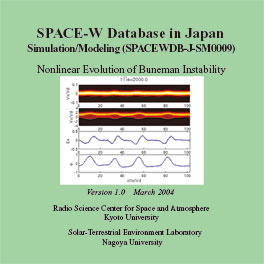Database in Japan
Observation (SPACEW-J-SM0009)
Version 1.0 March 2004
(CAWSES database in Japan)
Nonlinear Evolution of Buneman Instability

SM0009
| SPACE-W (Space Weather International Collaborative Research) Database in Japan Observation (SPACEW-J-SM0009) Version 1.0 March 2004 (CAWSES database in Japan) Nonlinear Evolution of Buneman Instability |
 SM0009 |
Nonlinear Evolution of Buneman Instability
Y. Omura(1), K. Ninomiya(1), T. Umeda(1), W. Heikkila(2), H. Matsumoto(1)
(1) Radio Science Center for Space and Atmosphere, Kyoto University, Uji Kyoto 611-0011, Japan
(2) Center for Space Sciences, University of Texas at Dallas, Richardson, TX 75083, USA
The Buneman instability is one of the most fundamental instabilities that arise along the magnetic field line, when thermal electrons are accelerated by an external electric field along the ambient magnetic field. Such electric fields are induced, when the magnetosphere undergoes dynamic changes of its structure such as magnetic reconnection or reconfiguration. We first assume a stable plasma with thermal electrons and ions at rest, where the thermal electrons and ions can have different temperatures as specified by the thermal velocities Ve and Vi, respectively. Under the electric field imposed along the magnetic field, the thermal electrons are accelerated to a finite drift velocity Vd relative to the thermal ions. When the Vd exceeds a critical value, the Buneman instability sets in to convert the drift kinetic energy to electrostatic field energy and thermal energies of electrons and ions. As the electrostatic field grows the electrons are rapidly diffused through nonlinear trapping motion [Omura et al., 2003].
We performed a series of electrostatic particle simulations [Omura and Matsumoto, 1993] starting with a finite drift velocity Vd and with various initial thermal velocities Ve/Vd and Vi/Vd. The nonlinear evolutions of the instability result in a wide variety of electrostatic potential structures along the magnetic field line such as isolated electron holes, isolated ion holes, double layers, and electron acoustic solitons. The final state of the nonlinear evolution also depends on whether the system is uniform with periodic boundaries or nonuniform with open boundaries.
In the present database of the SPACE-W project in Japan, we show a variety of nonlinear evolution processes of Buneman instability started with different sets of (Ve/Vd, Vi/Vd), presenting the animation of the phase space plots of ions and electrons in the (X, Vx) phase space, electric field Ex, and electrostatic potential ¦µ.
Simulation results
We have performed a large number of simulation runs for many point in the two-dimensional parameter space with different initial values of Ve/Vd and Vi/Vd, where Vi and Ve are the thermal velocities for ions and electrons, respectively, and Vd is the drift velocity of electrons. We assume a single ions species of protons. The charge neutrality condition of the plasma gives ni = ne. We assume a real mass ratio for protons and electrons, i.e., mi / me = 1836, which gives the ratio of the ion to electron plasma frequencies, ¦°i / ¦°e = 0.0233. The time is normalized by 1/¦°e, and velocities are normalized by the drift velocity Vd. The distance is normalized by Vd / ¦°e. We only solve the electrostatic mode in the direction parallel to the static magnetic field in this paper. Therefore, the polarization is purely parallel to the static magnetic field, and the magnitude of the magnetic field does not contribute to the electron dynamics. In this simple model, the controling parameters of the Buneman instabilities are the thermal velocities of ions and electrons, i.e., Ve/Vd and Vi/Vd. Since we normalize velocities by the drift velocity Vd, the thermal velocities of ions and electrons are specified with a reference to the drift velocity Vd = 1.
The simulation results are presented by animations of plots consisting of the following four panels. From the top, they are:
Phase space plot of ions in (X, Vx)
Phase space plot of electrons in (X, Vx)
Electric field Ex
Electrostatic potential ¦µ
References
Y. Omura, W. J. Heikkila, T. Umeda, K. Ninomiya, and H. Matsumoto, Particle simulation of plasma response to an applied electric field parallel to magnetic field lines, Journal of Geophysical Research, Vol. 108, no. A5, 1197, doi: 10.1029/2002JA009573, 2003.
Y. Omura and H. Matsumoto, KEMPO1: Technical Guide to One-Dimensional Electromagnetic Particle Code, Computer Space Plasma Physics: Simulation Techniques and Softwares, edited by H. Matsumoto and Y. Omura, pages 21-65, Terra Scientific, Tokyo , 1993.
Acknowledgments
Support for the production of SPACE-W Database was provided by grants in aid from the Japan Society for Promotion of Science (JSPS).
CONTACT:
Yoshiharu Omura
RASC, Kyoto University
Gokasho, Uji, Kyoto 611-0011
Japan
TEL: +81-774-38-3811 FAX: +81-774-31-8463
E-mail: omura[AT]kurasc.kyoto-u.ac.jp